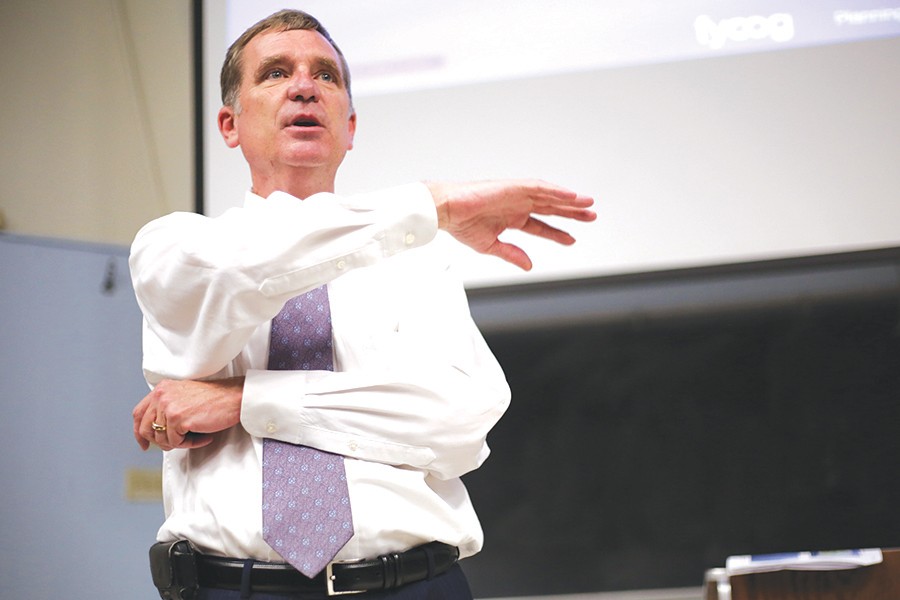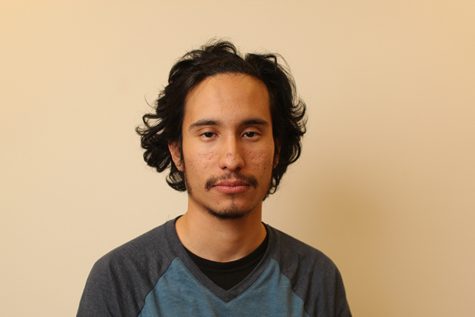Measure E update educates faculty
Christian Urrutia / The Advocate
District Chief Facilities Planner Ray Pyle discusses the district’s plan to use Measure E bond funds in LA-100 on Monday.
Sep 18, 2015
An update forum on the Measure E bond was held in LA-100 on Monday, meant to educate the college administrators on the background, planning parameters and process behind the measure.
The forum was hosted by district Chief Facilities Planner Ray Pyle, who explained each one of the facets concerning the Measure E bond program.
“My whole goal with using the Measure A 2002/2006 and now Measure E bonds is to transform the (Contra Costa College) campus to the best of our ability,” Pyle said.
Interim President Mojdeh Mehdizadeh said, “It is an opportunity for us to continue and expand the resources that we need to modernize our facilities.”
Pyle said, “Getting input from the college body is essential, since they’re the ones who are going to be inside these new buildings.”
Planning for Measure E began in 2007 with the Facilities Master Plan for CCC co-created by Perkins-Will, an architectural firm, Pyle said.
After most of phase one of the Facilities Master Plan was completed, the Contra Costa Community College District proceeded to look at phase two and three and wanted to validate further projects. Measure E provided a way to do so.
For CCC, the projects currently in place are: constructing a new Science and Allied Health Center or modernize current spaces housing the sciences and allied health educational programs; modernize or construct a campus operations building; and modernize the gym annex, gymnasium, locker rooms and other physical education facilities.
“(We’re) looking at potentially a lot of moving parts and trade-offs and things like that have to be made in order to get this program to go,” Pyle said.
One constraint that presents itself before the building process begins is the budget for the project list.
With the total projected amount for costs reaching $126 million, this creates a budget shortfall of about $41.6 million since the Measure E allocation caps out at $84.4 million.
But the budget contains two discrepancies; one being that the construction of the Biological Sciences Building will fall under the new science and allied health center or undergo an extensive renovation, the other being $5 million from the Measure A bond added to the allocation amount, bringing the total to $89.4 million.
This would make the actual budget shortfall a little more than $26 million.
“Through the planning process we try to find ways to save money or find cost effective ways so it is hard to be precise with the budget in the beginning,” Pyle said.
Seismic constraints consisted of one of the planning parameters discussed with emphasis on how no buildings can be installed that rest on active traces of the Hayward Fault, an active geological fault that bisects CCC’s campus.
According to a seismic study of campus conducted by Kleinfelder, Inc. in 2012, certain areas of the campus are designated by red, yellow and green colors to represent areas that are unsafe for construction, questionable areas for construction and areas that are cleared for construction, respectively.
Pyle said new buildings cannot be built unless the land is made green by trenching to find pre-Holocene soils that are absent of fault traces, or by other indirect analytical testing that may be inconclusive.
Moving forward each project will have user groups made up of current or future building occupants. Information technology and operations teams will be part of all project user groups and input on design and adjacencies and functional space requirements will be taken during the design process, Pyle said.
Design decisions will also be reported back to user groups and these same groups will be asked to sign off on the designs prior to final approval, he said.



